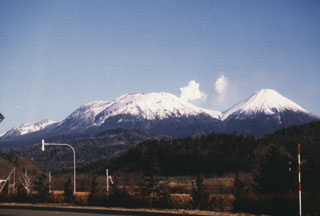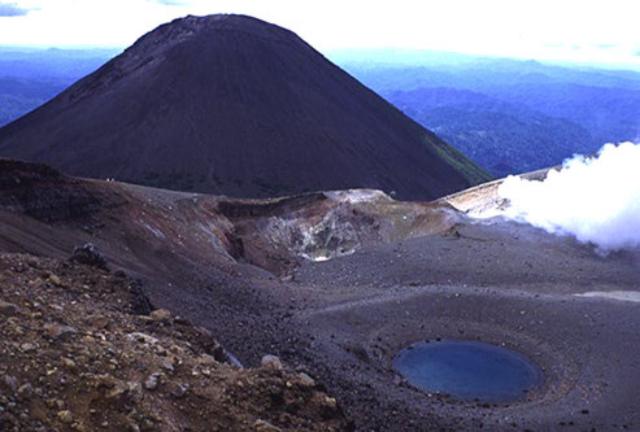Report on Akan (Japan) — October 1998
Bulletin of the Global Volcanism Network, vol. 23, no. 10 (October 1998)
Managing Editor: Richard Wunderman.
Akan (Japan) Small-scale ash eruption on 9 November
Please cite this report as:
Global Volcanism Program, 1998. Report on Akan (Japan) (Wunderman, R., ed.). Bulletin of the Global Volcanism Network, 23:10. Smithsonian Institution. https://doi.org/10.5479/si.GVP.BGVN199810-285070
Akan
Japan
43.384°N, 144.013°E; summit elev. 1499 m
All times are local (unless otherwise noted)
On 9 November the Japanese Meteorological Agency (JMA) issued two "Volcanic Advisories" and a "Volcano Observation Report" following a small-scale eruption at Me-Akan volcano ~225 km E of Sapporo. New ash deposits were observed on trees in the nearby town of Akan, located E of the volcano near Lake Akan, and trace amounts of ash were distributed up to ~10 km E from the summit crater. JMA and Hokkaido University seismometers detected 4 minutes of tremor beginning at 1441 on 9 November. No additional earthquake or tremor events followed.
According to the local news agency, Asahi Shinbun, one of their aircraft flew near the snow-covered summit of the volcano at approximately 0900 on 10 November. White-colored "smoke" was seen to rise 700 m above the Ponmachineshiri crater (figure 7). Observers also noted that snow fields up to 1 km S and E of the crater were gray in color. There were no reports of injuries or damage.
Researchers from Hokkaido University, the Geological Survey of Japan (Hokkaido Branch), Geological Survey of Hokkaido, and JMA (Sapporo and Kushiro) surveyed ash deposits from the 9 November eruption, and examined the ash under a petrological microscope. They estimated the total mass of the deposits as ~1,000 metric tons (t), smaller than the ~2,000 t eruption in 1996 (BGVN 21:10). The ash consisted of older, altered rock-fragments (andesite), minerals and clay. They found trace amounts of angular, fresh basalt fragments containing gray glass. They considered it likely that new magma reacted with water in a hydrothermal system, resulting in a phreatomagmatic eruption in which chips of solidified new magma were issued together with larger amounts of fragments of older rocks altered hydrothermally beneath the crater.
Geological Summary. Akan is a 13 x 24 km caldera located immediately SW of Kussharo caldera. The elongated, irregular outline of the caldera rim reflects its incremental formation during major explosive eruptions from the early to mid-Pleistocene. Growth of four post-caldera stratovolcanoes, three at the SW end of the caldera and the other at the NE side, has restricted the size of the caldera lake. Conical Oakandake was frequently active during the Holocene. The 1-km-wide Nakamachineshiri crater of Meakandake was formed during a major pumice-and-scoria eruption about 13,500 years ago. Within the Akan volcanic complex, only the Meakandake group, east of Lake Akan, has been historically active, producing mild phreatic eruptions since the beginning of the 19th century. Meakandake is composed of nine overlapping cones. The main cone of Meakandake proper has a triple crater at its summit. Historical eruptions at Meakandake have consisted of minor phreatic explosions, but four major magmatic eruptions including pyroclastic flows have occurred during the Holocene.
Information Contacts: J. Miyamura, Japan Meteorological Agency, Kishocho-881, 3-4 Ote-machi, Chiyoda-ku, Tokyo 100-0004, Japan; Mitsuhiro Nakagawa, Department of Earth and Planetary Material Sciences, Graduate School of Science, Hokkaido University, N-10 W-8 Kita-ku, Sapporo 060, Japan; Asahi Shimbun News, Tokyo, Japan (URL: http://www.asahi.com/); Keiji Wada, Hokkaido University of Education at Asahikawa, Hokumoncho 9-chome, Asahikawa 070,Japan (URL: http://www.asa.hokkyodai.ac.jp/research/staff/wada/EV/E-Welcome.html); Volcano Research Center, Earthquake Research Institute (ERI), University of Tokyo, Yayoi 1-1-1, Bunkyo-ku, Tokyo 113, Japan (URL: http://www.eri.u-tokyo.ac.jp/VRC/index_E.html).


